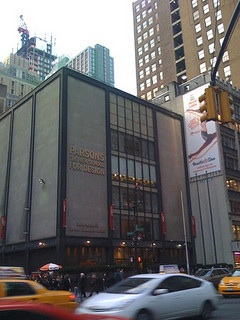Report finds New York's design schools fuel creative economy


Why do studies on the relationship between college-level institutions and innovation often overlook design schools? Are fashion, art, and architecture schools fertile grounds for conceiving and launching successful start-up companies, just as engineering departments at research universities are? These questions are asked, and addressed, in a newly published report from the Center for an Urban Future, a think tank. Focusing on New York City, the publication argues that New York's design schools have become "critical catalysts for innovation, entrepreneurship, and economic growth."
To begin with, New York graduates the most design and architecture degrees than any other U.S. city. In 2010, that number was 4,278-- compared to only 1,769 in Los Angeles (the metropolis with the second-largest batch of design-diploma recipients), 1,552 in Chicago, and 1,343 in San Francisco. New York's newly minted designers provide the creative industries with a talent pipeline to established companies. They also start new ventures in the city. The report states that nearly 20% of graduates from Pratt, Parsons the New School for Design (pictured above), and the School of Visual Arts--some of the most prestigious design schools in the nation and the world, all based in New York--start their own businesses.
This figure is especially impressive given that only 21 start-ups, total, were created among new alumni of New York's top-tier research institutions in 2007, including Columbia, New York University, and the Mt. Sinai School of Medicine, among others in scientific and engineering fields.
The impact of New York's design graduates on the city's economy is likely to increase, the report suggests, as the number of design diploma holders has been increasing rapidly between 2005-2010, up 40% in this time, compared to a mere 18% increase in economics degrees in the city during the same period.
The report also includes a new survey of professional designers on the topic of design graduates' impact on their industry. It found that
- Eighty percent of those surveyed said that New York's design schools were either "extremely important" or "important" in the local economy
- Eighty-two percent said New York design school graduates were "important local resources" for their businesses
- Eighty-one percent said they hired at least one New York City design school graduate in the last five year
- Thirty-nine percent who started their own businesses graduated from New York design schools
- Less positively, only 12% said New York's design schools provided "significant opportunities" to develop business and entrepreneurial skills, and 44% said business was not a major focus
The report concludes with recommendations on how to encourage an even more fruitful relationship between New York's design schools and the city's local--as well as national and international--business world. These are:
- Expand and improve opportunities for design students to learn business skills. This includes offering specific classes on areas such as intellectual property laws and tax filing, as well as support from New York's Economic Development Corporation.
- Connect design and architecture students to small businesses in New York that could benefit from better design. This would offer valuable real-world experience to students, and affordable services to existing entrepreneurs.
- Develop programs that capitalize on New York's strengths in business consulting, philanthropy, and health care. Schools could create concentrations in each of these fields and groom students to work in these growing sectors.
- Link New York's new applied sciences campus to design. The two universities (Cornell and the Technion-Israel Institute of Technology) selected to develop this campus on Roosevelt Island have said their focus will be on health care, environmental technology, and digital media. These are areas that design students and graduates could contribute to, similar to cross-disciplinary efforts at MIT's Media Lab or the Mayo Clinic's Center for Innovation.
- Develop new design incubators and work share spaces for promising graduates. Why not treat design start-ups as technology start-ups are treated-- as viable businesses that could use affordable office spaces and communities of like-minded entrepreneurs and potential funders?
- Develop a high-profile design week, and make the city's design schools a key part of it. Although many cities around the globe are hosting week-long official design celebrations, New York technically does not. If New York does develop one, it could be a terrific opportunity for creative students to contribute their skills to organizing. As well as a venue to show off their talents and fledgling businesses.
- Develop innovative interdisciplinary programs. Matching design and architecture students and recent grads with peers in the fields of business and engineering could be informative for all--and possibly hatch adventurous new start-ups.
While the report's observations and tips are obviously intended to motivate New York's design schools, alumni, politicians, and business and engineering communities alike, they could certainly inspire students, professors, entrepreneurs, and financial backers in other cities and nations. After all, New York has long been a leader in the design industry. It's a role it can also play in the new realm of studying how design schools can help drive local economies.
Photo: Lucius Kwok/Flickr
This post was originally published on Smartplanet.com